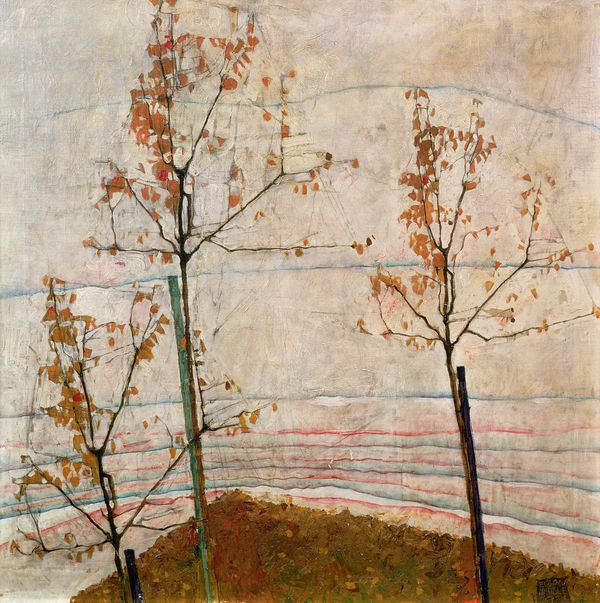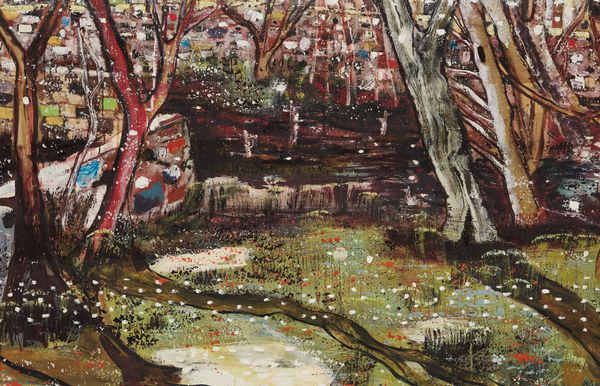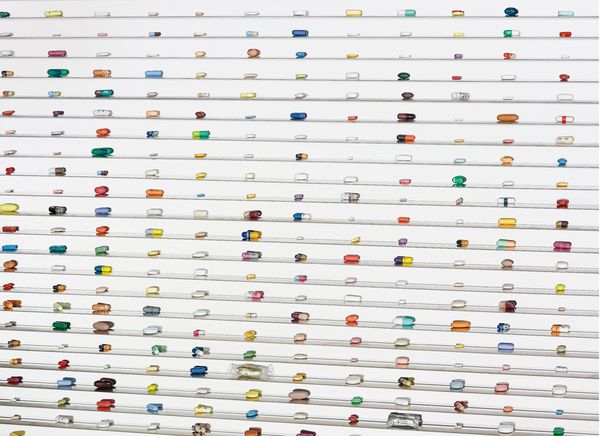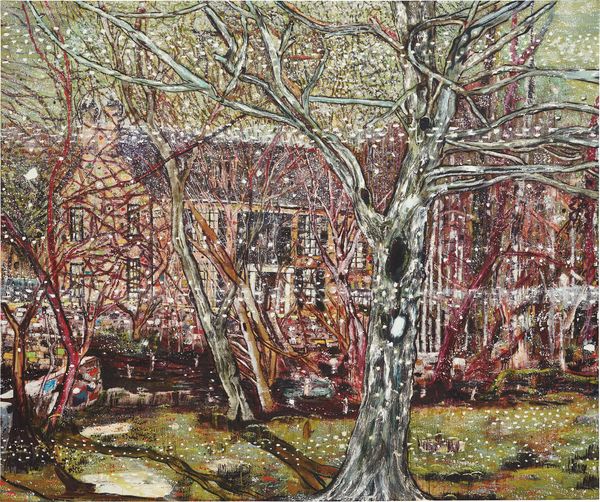Peter Doig Rosedale, 1991 (detail)
Both Peter Doig's Rosedale from 1991 and Damien Hirst's The Void from 2000 achieve the dazzling feat of reinventing Impressionism for the contemporary viewer. The two artists succeed in their goal through very different paths: Peter Doig through building layers of references and quotes from modern, popular and commercial art with utterly sophisticated style and intellectual clarity, Damien Hirst condensing his language from the opposite side of the art historical spectrum, one of minimalism and conceptual art.
Damien Hirst The Void, 2000 (detail). Glass, stainless steel, steel, aluminum, nickel, bismuth and cast resin, colored plaster and painted pills with dry transfers.
Both artists dare to walk on a tightrope stretched over the canyon between kitsch and elitism, avoiding the plunge into sheer bad taste or a chilling theoretical mood. In both cases the result is deeply emotional and spectacular within the boundaries of painting, even if in the case of Hirst, no paint or canvas have been used. Damien Hirst's The Void is reminiscent of the stillness of George Seurat's masterpiece La Grande Jatte from 1886. Seurat's pointillist style is substituted by the color of the many pills which surpass the retinal experience to express a psychological dimension activated symbolically by the many drugs which have become a common vessel to maintain a balance in the frantic contemporary world, as much as Sunday afternoons functioned in his time as calming events in the faster pace of the booming modern world.

Georges Seurat A Sunday on La Grande Jatte, 1884-1886. Oil on canvas, The Art Institute of Chicago. Bridgeman Images.
The viewers reflected into the stainless steel vitrine become like the dazed figures in Seurat's canvas — present and yet unreal. Hirst choses the path of performing visual surgery transforming images and people into pills, fragmenting the gaze which will wonder across a colorful and ordered constellation in order to control the chaos of our feelings and impressions.
Hirst's The Void is a contemporary attempt to regain control on a reality gone adrift since the time of Charles Baudelaire's The Painter of Modern Life. The modern visual revolution carried on by the Impressionists is confronted by Hirst's The Void questioning both the subservient attitude of modern artists at the end of 19th century toward an overwhelming reality, and the ideological order imposed in the late 1960s by the theories and obligations of the minimalist artists. Never was a void filled with such experiential content, nor flatness gifted with so much depth.
Peter Doig Rosedale, 1991. Oil on canvas.
While still departing from what we could define again as a contemporary impressionism, Peter Doig moves swiftly away from 19th century urban environment and goes into some kind of Americana mood embracing visual narrative and creating an accumulation of imageries not afraid to craze and confront cheesiness or decorative taste. Doig's painterly grammar subliminally contains quotations of Egon Schiele's landscapes and Piet Mondrian's early woods, but also we can discover tongue-in-cheek references to popular phenomena such as Thomas Kinkade or Christmas' iconography.

Egon Schiele Autumn Trees, 1911. Oil on canvas, Private Collection/Bridgeman Images.
The density of Doig's Rosedale is astonishing. Under the furry surface we can discover the ghosts of Frank Lloyd Wright's architecture and Walt Whitman's poetry and maybe the eerie mood of isolation carried over from the Unabomber cabin. Beauty is both disguised and overly apparent in Doig's early paintings; Rosedale is one of the most successful examples of what may be his most radical achievement. He deals with and balances traditional iconography with an utterly new sensitivity that makes him one of the masters of contemporary painting today. Melancholia and nostalgia are eradicated from Doig's scenes, replaced by a sense of security that only nature can transmit to the viewer. Doig places the viewer in the role of the wanderer who after a long hike discovers the house as a kind of revelation, the promised place sought with much desire. Softness takes the place of toughness, the harshness of the wilderness is made smooth by the snowflakes unifying the picture—a complicated painting in its quest for simplicity.
Face to face, Damien Hirst's The Void and Peter Doig's Rosedale open up a conversation and a debate on how, through extremely different methods, contemporary artists can transform art history avoiding sheer provocation, creating a red line that connects the birth of modern art with the many and contradicting manifestations of contemporary art while still moving forward. Conceived and realized with completely different materials, The Void and Rosedale are able to conquer similar emotions and appreciation.
Hirst and Doig belong to the same generation of artists, and both have looked at the past and its art without longing but instead as a fountain of youth where old ideas and languages can be rejuvenated and reinvented in order to address the issues and the sensibilities of the present. The two artists discarded any cynical attitude in the making of their art, trusting the endless healing power of art itself. If Hirst's inquiry into the power of chemical substances to change our perception of reality turns toward a more industrial, artificial and rational result, Doig's more poetic and naïve approach turns more into the magical atmosphere of storytelling.
Hirst's surgical mind is Doig's lyrical soul, both serving the same master — art — and its eternal power to produce awe and inspiration for our daily if at times uneventful life.


